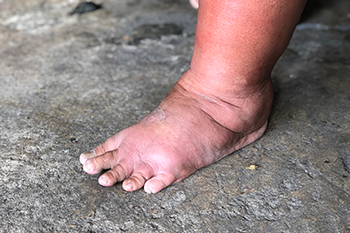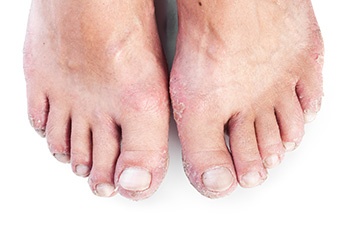
It is generally safe for individuals to have outpatient foot and ankle surgeries at freestanding ambulatory surgery centers, a phenomenon becoming more common in the podiatry field. This trend offers cost savings and efficiency compared to traditional hospital settings. Because of unique postoperative challenges, it is necessary to make sure these facilities can handle such procedures. Foot and ankle surgeries can carry a higher risk of infection, with diabetes as a common comorbidity, and blood clots, perhaps from swift patient discharge. If you are facing foot surgery, it is suggested that you make an appointment with a podiatrist to see if outpatient surgery will work for you.
Foot surgery is sometimes necessary to treat a foot ailment. To learn more, contact Barry P. Weinstein, DPM of Bellaire Podiatry. Our doctor will assist you with all of your foot and ankle needs.
When Is Surgery Necessary?
Foot and ankle surgery is generally reserved for cases in which less invasive, conservative procedures have failed to alleviate the problem. Some of the cases in which surgery may be necessary include:
What Types of Surgery Are There?
The type of surgery you receive will depend on the nature of the problem you have. Some of the possible surgeries include:
Benefits of Surgery
Although surgery is usually a last resort, it can provide more complete pain relief compared to non-surgical methods and may allow you to finally resume full activity.
Surgical techniques have also become increasingly sophisticated. Techniques like endoscopic surgery allow for smaller incisions and faster recovery times.
If you have any questions please feel free to contact one of our offices located in Bellaire and Houston, TX . We offer the newest diagnostic and treatment technologies for all your foot and ankle needs.

Heel spurs are bony protrusions on the underside of the heel bone that in some cases can cause discomfort and pain. It is generally believed that heel spurs form when calcium deposits accumulate over several months on the calcaneus, or heel bone. However, heel spurs can also be associated with other foot issues, such as plantar fasciitis, where inflammation of the tissue under the foot can contribute to their development. In addition, certain medical conditions like gout, rheumatoid arthritis, and ankylosing spondylitis, all of which damage the joints, can result in heel spurs. Risk factors of heel spurs include having flat feet, engaging in high-impact aerobic exercises, and aging, particularly among people over 62 years old. Obesity, overpronation, and wearing high heels can significantly raise the risk of heel spur development. In fact, younger women tend to have a higher incidence of heel spurs, possibly due to the use of high heels, which can impact foot biomechanics. If you're experiencing heel pain, especially if it's persistent, it's suggested that you make an appointment with a podiatrist for a proper diagnosis and tailored treatment plan.
Heel spurs can be incredibly painful and sometimes may make you unable to participate in physical activities. To get medical care for your heel spurs, contact Barry P. Weinstein, DPM from Bellaire Podiatry. Our doctor will do everything possible to treat your condition.
Heels Spurs
Heel spurs are formed by calcium deposits on the back of the foot where the heel is. This can also be caused by small fragments of bone breaking off one section of the foot, attaching onto the back of the foot. Heel spurs can also be bone growth on the back of the foot and may grow in the direction of the arch of the foot.
Older individuals usually suffer from heel spurs and pain sometimes intensifies with age. One of the main condition's spurs are related to is plantar fasciitis.
Pain
The pain associated with spurs is often because of weight placed on the feet. When someone is walking, their entire weight is concentrated on the feet. Bone spurs then have the tendency to affect other bones and tissues around the foot. As the pain continues, the feet will become tender and sensitive over time.
Treatments
There are many ways to treat heel spurs. If one is suffering from heel spurs in conjunction with pain, there are several methods for healing. Medication, surgery, and herbal care are some options.
If you have any questions feel free to contact one of our offices located in Bellaire and Houston, TX . We offer the latest in diagnostic and treatment technology to meet your needs.

Extensor tendonitis is a common foot issue that causes discomfort across the top of the foot. This condition stems from irritation or inflammation of tendons that are critical for lifting the toes. Repetitive friction and pressure, often due to ill-fitting shoes, are common causes of extensor tendonitis. The primary tendons involved are the extensor hallucis longus, which lifts the big toe, and the extensor digitorum, for the other toes. Extending from lower leg muscles, these tendons cross the front of the ankle, span the upper foot, and attach to toe tips. Their limited protection renders them susceptible to injuries and leads to pain. Overuse or excessive pressure causes inflammation and swelling in these tendons. In time, this can weaken them and cause scarring that reduces flexibility and strength. Risk factors include tight shoes, prolonged weight-bearing, and calf muscle tightness. Pain from extensor tendonitis usually worsens with activity but subsides during rest. Common signs are swelling, tenderness, and bruising. If you are experiencing symptoms of extensor tendonitis, it is suggested that you make an appointment with a podiatrist for a diagnosis and the appropriate treatment options.
Foot Pain
Foot pain can be extremely painful and debilitating. If you have a foot pain, consult with Barry P. Weinstein, DPM from Bellaire Podiatry. Our doctor will assess your condition and provide you with quality foot and ankle treatment.
Causes
Foot pain is a very broad condition that could be caused by one or more ailments. The most common include:
Diagnosis
To figure out the cause of foot pain, podiatrists utilize several different methods. This can range from simple visual inspections and sensation tests to X-rays and MRI scans. Prior medical history, family medical history, and any recent physical traumatic events will all be taken into consideration for a proper diagnosis.
Treatment
Treatment depends upon the cause of the foot pain. Whether it is resting, staying off the foot, or having surgery; podiatrists have a number of treatment options available for foot pain.
If you have any questions, please feel free to contact one of our offices located in Bellaire and Houston, TX . We offer the newest diagnostic and treatment technologies for all your foot care needs.

An ankle sprain can result in persistent pain and swelling despite rest and physical therapy. The location of the pain can indicate different issues. Frontal pain may suggest damage within the ankle joint or at the front of the ankle. Patients with joint surface injuries or front ankle problems typically experience discomfort during walking, running, or jumping activities, with increased pain on stairs or uneven surfaces. Lateral or side ankle pain may arise from synovitis, which is inflammation of the joint lining, due to a recent sprain, tendon tears, dislocation, or hidden fractures. Synovitis causes front ankle pain, worsening with activities like stair climbing and running, accompanied by swelling and reduced joint motion. Peroneal tendon tears usually manifest as delayed lateral ankle pain and swelling, aggravated by physical activity, especially on uneven terrain. Fractures can mimic sprains but require different treatments. Treatment for ankle sprains may include immobilization, medication, or surgery. If you have sprained your ankle, it is strongly suggested that you make an appointment with a podiatrist for a diagnosis and an individualized treatment plan.
Ankle pain can have many different causes and the pain may potentially be serious. If you have ankle pain, consult with Barry P. Weinstein, DPM from Bellaire Podiatry. Our doctor will assess your condition and provide you with quality foot and ankle treatment.
Ankle pain is any condition that causes pain in the ankle. Due to the fact that the ankle consists of tendons, muscles, bones, and ligaments, ankle pain can come from a number of different conditions.
Causes
The most common causes of ankle pain include:
Symptoms
Symptoms of ankle injury vary based upon the condition. Pain may include general pain and discomfort, swelling, aching, redness, bruising, burning or stabbing sensations, and/or loss of sensation.
Diagnosis
Due to the wide variety of potential causes of ankle pain, podiatrists will utilize a number of different methods to properly diagnose ankle pain. This can include asking for personal and family medical histories and of any recent injuries. Further diagnosis may include sensation tests, a physical examination, and potentially x-rays or other imaging tests.
Treatment
Just as the range of causes varies widely, so do treatments. Some more common treatments are rest, ice packs, keeping pressure off the foot, orthotics and braces, medication for inflammation and pain, and surgery.
If you have any questions, please feel free to contact one of our offices located in Bellaire and Houston, TX . We offer the newest diagnostic and treatment technologies for all your foot care needs.

Cycling offers numerous health benefits, including cardiovascular improvement, enhanced joint mobility, and strengthened leg muscles. However, cycling without the proper footwear also can strain your lower limbs. While regular running shoes are suitable for occasional cyclists, dedicated cyclists who spend hours daily on the road or in the gym require specialized cycling shoes. Orthotics can play a pivotal role in boosting cycling performance as they can help to increase pedal efficiency, enhance power output, and improve foot stability. They also can help to reduce foot fatigue, improve arch support, provide better metatarsal padding, and offer relief from plantar fascial tension. Custom-made shoe insoles are an important consideration for cycling enthusiasts with flat feet, supination, pronation issues, or specific conditions like plantar fasciitis. A podiatrist can make a set of orthotics designed to fit your unique foot structure, using custom molds that mirror the exact shape of the foot. For help with custom shoe inserts made specifically for cycling shoes, it is suggested that you make an appointment with a podiatrist.
If you are having discomfort in your feet and would like to try orthotics, contact Barry P. Weinstein, DPM from Bellaire Podiatry. Our doctor can provide the care you need to keep you pain-free and on your feet.
What Are Orthotics?
Orthotics are inserts you can place into your shoes to help with a variety of foot problems such as flat feet or foot pain. Orthotics provide relief and comfort for minor foot and heel pain but can’t correct serious biomechanical problems in your feet.
Over-the-Counter Inserts
Orthotics come in a wide variety of over-the-counter inserts that are used to treat foot pain, heel pain, and minor problems. For example, arch supports can be inserted into your shoes to help correct overarched or flat feet, while gel insoles are often used because they provide comfort and relief from foot and heel pain by alleviating pressure.
Prescription Orthotics
If over-the-counter inserts don’t work for you or if you have a more severe foot concern, it is possible to have your podiatrist prescribe custom orthotics. These high-quality inserts are designed to treat problems such as abnormal motion, plantar fasciitis, and severe forms of heel pain. They can even be used to help patients suffering from diabetes by treating foot ulcers and painful calluses and are usually molded to your feet individually, which allows them to provide full support and comfort.
If you are experiencing minor to severe foot or heel pain, it’s recommended to speak with your podiatrist about the possibilities of using orthotics. A podiatrist can determine which type of orthotic is right for you and allow you to take the first steps towards being pain-free.
If you have any questions please contact one of our offices located in Bellaire and Houston, TX . We offer the newest diagnostic and treatment technologies for all your foot and ankle needs.

Various foot conditions can make movement difficult. Chief among them is cracked heels. As one ages, skin becomes thinner and dryer and the skin on the heels can form calluses, or dead skin, and can develop cracks. This often happens because the heels endure a lot of pressure from walking and the skin is dry. Cracked heels can become painful and make walking difficult. If they get bad enough, fissures can develop and the cracks deepen, can bleed, and be a breeding ground for infection. If one has diabetes, peripheral artery disease, or poor circulation, cracked heels can become serious foot wounds that are difficult to heal. Hydration and moisturizing the feet can help with cracked heels, as can wearing socks with cushioned shoes and temporarily cutting down on activities that put pressure on the heels. If you have cracked heels and the condition is causing you discomfort or it is worsening, it is strongly suggested that you make an appointment with a podiatrist who can make sure that is what you are dealing with and provide treatment.
If the skin on your feet starts to crack, you may want to see a podiatrist to find treatment. If you have any concerns, contact Barry P. Weinstein, DPM from Bellaire Podiatry. Our doctor can provide the care you need to keep you pain-free and on your feet.
Cracked Heels
It is important to moisturize your cracked heels in order to prevent pain, bleeding, and infection. The reason cracked heels form is because the skin on the foot is too dry to support the immense pressure placed on them. When the foot expands, the dry skin on the foot begins to split.
Ways to Help Heal Them
Ways to Prevent Cracked Heels
If you are unsure how to proceed in treating cracked heels, seek guidance from a podiatrist. Your doctor will help you with any questions or information you may need.
If you have any questions, please feel free to contact one of our offices located in Bellaire and Houston, TX . We offer the newest diagnostic and treatment technologies for all your foot care needs.

The ankle, a vital joint in our body, plays a significant role in our movements and stability. However, some individuals may notice that their ankles are large or swollen, raising concerns. In most cases, the size and shape of our ankles are determined by genetics, and having larger ankles is not inherently unhealthy. However, certain health conditions can cause enlarged ankles, warranting attention and further investigation. One such condition is lipedema, a painful disorder where fat accumulates beneath the skin of the legs. Lipedema predominantly affects women, and its symptoms include easy bruising, sensitivity to pressure, and difficulty walking. Genetic factors and hormonal changes trigger this condition, and treatments involve dietary changes, exercise, and specialized therapy. Another condition that can lead to swollen ankles is lymphedema, which involves abnormal swelling due to a compromised lymphatic system. Damaged lymph nodes or cancer treatments can be contributing factors. Managing lymphedema includes gentle exercises, compression techniques, and massages. Furthermore, edema, or generalized swelling, can cause puffy ankles as can heat, venous insufficiency, deep vein thrombosis, congestive heart failure, liver disease, kidney disease, medications, and pregnancy. For those seeking to reduce ankle swelling, lifestyle changes such as exercises, reducing sodium intake, elevating feet, and staying active can be beneficial. If you are generally concerned about the size of your ankles and they are causing you discomfort, it is suggested that you make an appointment with a podiatrist who can examine them and provide you with relief options.
Swollen feet can be a sign of an underlying condition. If you have any concerns, contact Barry P. Weinstein, DPM of Bellaire Podiatry. Our doctor can provide the care you need to keep you pain-free and on your feet.
Swollen feet are a common ailment among pregnant women and people who stand or sit for extended periods. Aging may increase the possibility of swollen feet and patients who are obese often notice when their feet are swelling too. There may be medical reasons why swollen feet occur:
Swollen feet can also be caused by bone and tendon conditions, including fractures, arthritis, and tendinitis. Additionally, there may be skin and toenail conditions and an infection may cause the feet to swell. Patients who take medicine to treat high blood pressure may be prone to getting swollen feet.
Many patients elevate their feet to help relieve the swelling and this is generally a temporary remedy. When a podiatrist is consulted the reason behind the swelling can be uncovered and subsequently treated.
If you have any questions please feel free to contact one of our offices located in Bellaire and Houston, TX . We offer the newest diagnostic tools and technology to treat your foot and ankle needs.

Psoriatic arthritis, or PsA, is a type of inflammatory arthritis that can manifest in individuals with the autoimmune skin condition psoriasis. This form of arthritis primarily affects the feet and ankles, bringing about inflammation and pain in the joints and supporting structures. PsA is frequently associated with various other foot conditions, including Achilles tendonitis, dactylitis, and plantar fasciitis. Achilles tendonitis is characterized by a painful inflammation of the tendon connecting the calf muscles to the heel where it attaches to the heel bone. Dactylitis involves severe inflammation around the toe joints, leading to swelling that gives the toes a sausage-like appearance and induces rigidity and pain when flexing. Plantar fasciitis refers to inflammation where the plantar fascia attaches to the heel bone, causing discomfort and hindrance in movement. As PsA progresses, it can significantly impede walking and performing daily activities, imposing substantial discomfort and limiting one's ability to engage in regular life pursuits. A cure for PsA does not exist yet, but various treatment options are available to manage the condition, slow its progression, and alleviate the associated symptoms. If you suspect or experience symptoms indicative of psoriatic arthritis, it is strongly suggested that you seek help from a qualified podiatrist for a proper diagnosis and personalized treatment.
Arthritis can be a difficult condition to live with. If you are seeking treatment, contact Barry P. Weinstein, DPM from Bellaire Podiatry. Our doctor can provide the care you need to keep you pain-free and on your feet.
Arthritic Foot Care
Arthritis is a term that is commonly used to describe joint pain. The condition itself can occur to anyone of any age, race, or gender, and there are over 100 types of it. Nevertheless, arthritis is more commonly found in women compared to men, and it is also more prevalent in those who are overweight. The causes of arthritis vary depending on which type of arthritis you have. Osteoarthritis for example, is often caused by injury, while rheumatoid arthritis is caused by a misdirected immune system.
Symptoms
Arthritic symptoms range in severity, and they may come and go. Some symptoms stay the same for several years but could potentially get worse with time. Severe cases of arthritis can prevent its sufferers from performing daily activities and make walking difficult.
Risk Factors
If you suspect your arthritis is affecting your feet, it is crucial that you see a podiatrist immediately. Your doctor will be able to address your specific case and help you decide which treatment method is best for you.
If you have any questions, please feel free to contact one of our offices located in Bellaire and Houston, TX . We offer the newest diagnostic and treatment technologies for all your foot care needs.